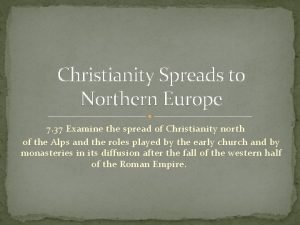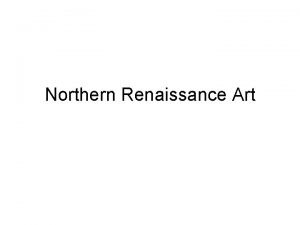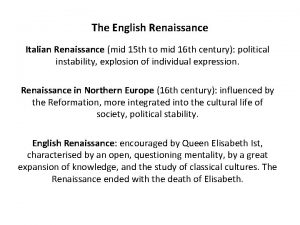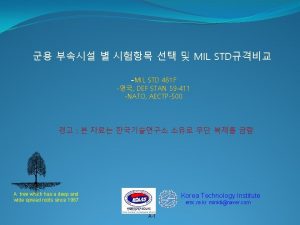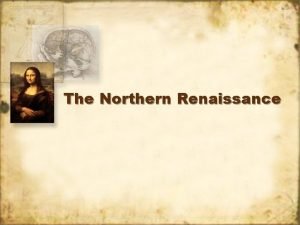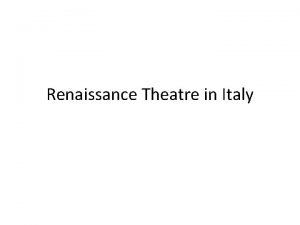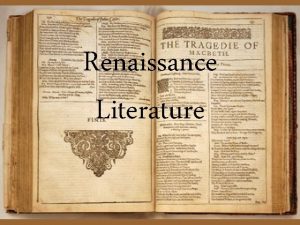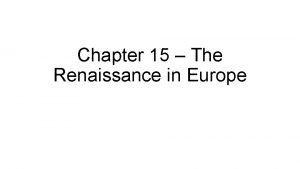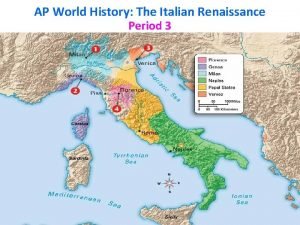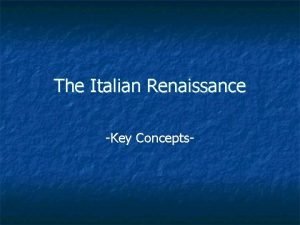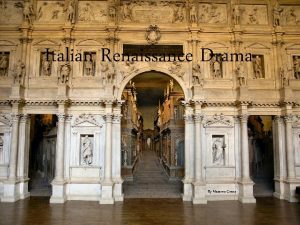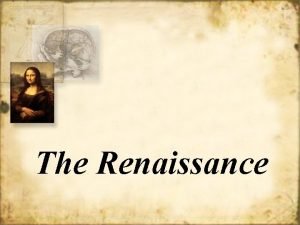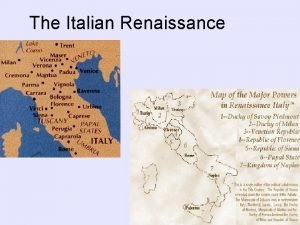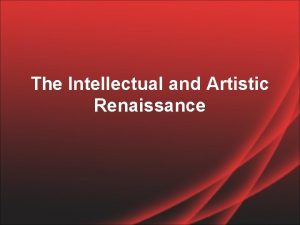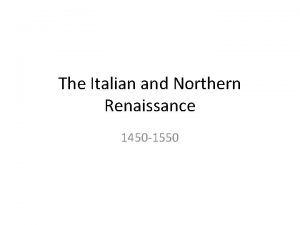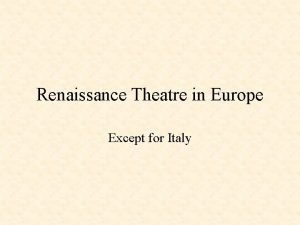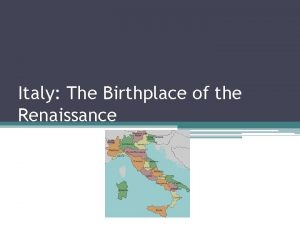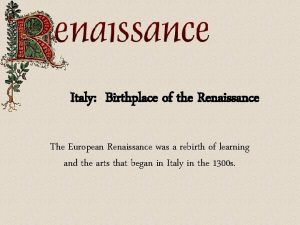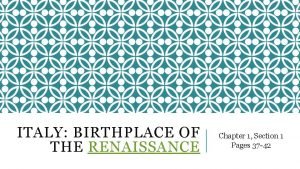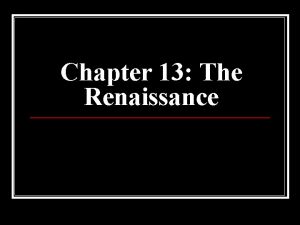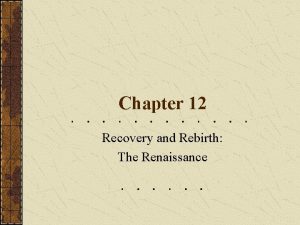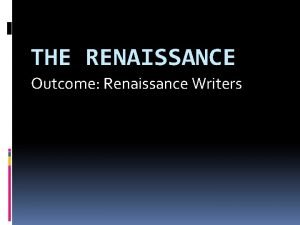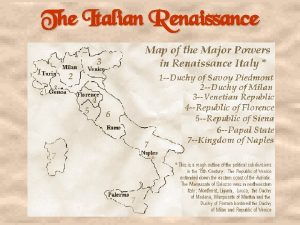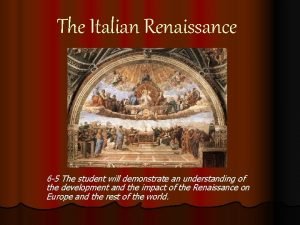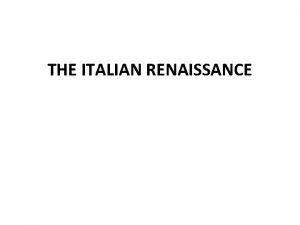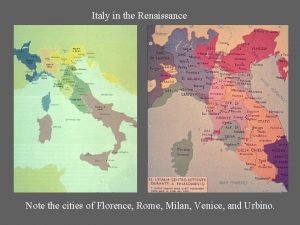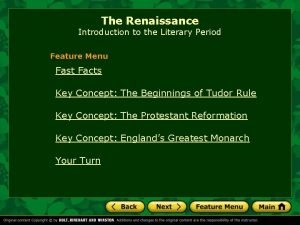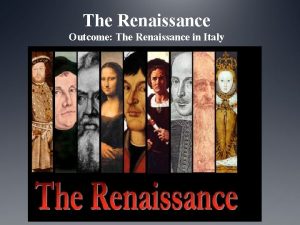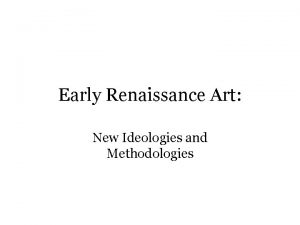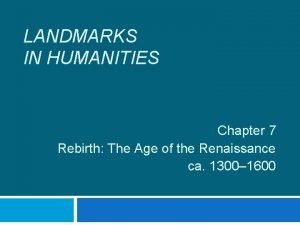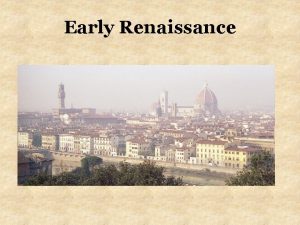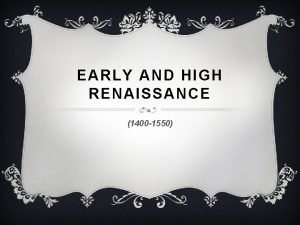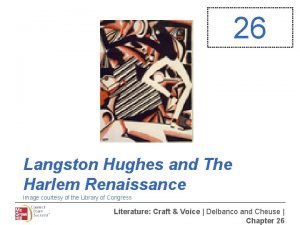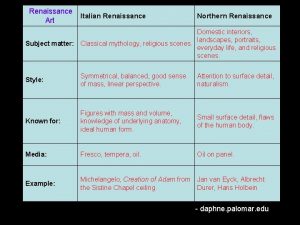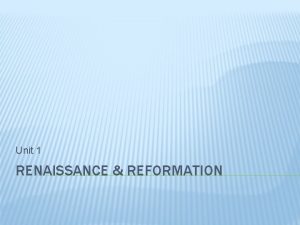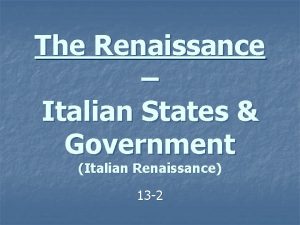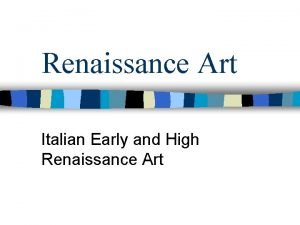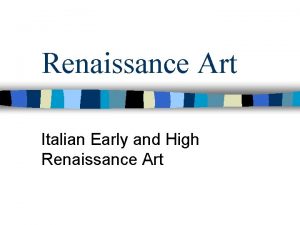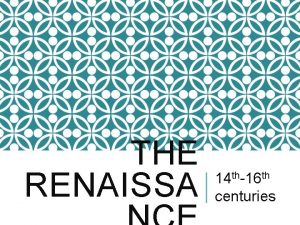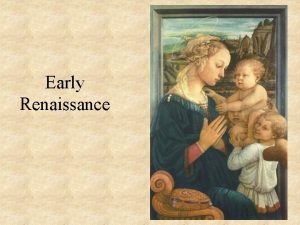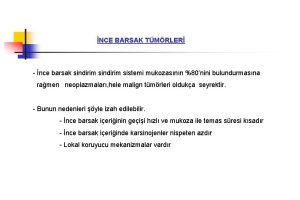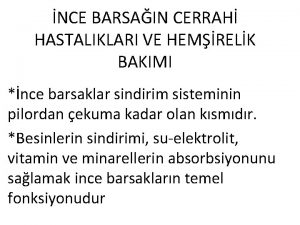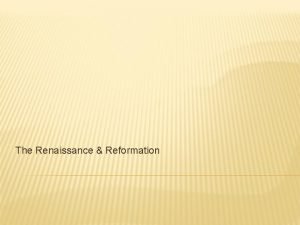Italian Renaissa nce Italian Renaissance Early Facts There












































- Slides: 44

Italian Renaissa nce

Italian Renaissance

Early Facts • There was an extensive growth in trade in Italy. As the merchant class grew and their wealth increased as did their leisure time and their eagerness to display their fortunes. As a result, a patronage system developed in which wealthy folks started to give financial support to artists. • Like the Roman and Medieval periods the Italian Renaissance is not known for its great playwrights. • Most plays written were staged, or sometimes read aloud at academies – formal institutions of learning – for wealthy patrons. • The printing press made plays and works of Aristotle and Horace more available than ever before.

Opera

Oper a

Opera The only theatrical form of the Italian Renaissance to survive.

Opera The only theatrical form of the Italian Renaissance to survive. Most operas are completely sung, and dramatic action, mood, and characters are created though song and music.

Opera Opera’s lean very heavily on the use of Spectacle While there are some humorous ones, most Opera’s are Tragedies – i. e. they do not end happily • Opera’s are traditionally written in one of the Romantic languages (Italian, Spanish, Latin, etc. )

Opera Vocabulary • Libretto - The text of an opera o. Aria – a solo song accompanied by the orchestra o. Duets , Trios, Quartets

Commedia dell’Arte

Commedia dell’Arte

Commedia dell’Arte • Chief entertainment of the Italian Renaissance

Commedia dell’Arte • Chief entertainment of the Italian Renaissance Traveling companies, usually consisting of about 10 performers – seven men and three women.

Commedia dell’Arte • Chief entertainment of the Italian Renaissance Traveling companies, usually consisting of about 10 performers – seven men and three women. Usually staged comedies. Was not written down, but rather consisted of improvise presentations.

Commedia dell’Arte Scenarios – a short script without dialogue – were written by members of a company. These scripts provided plot outlines as the actors invented the words and actions as they went along though improvisation.

Commedia dell’Arte Stock Characters Stereotypical person whom audiences recognize from frequent recurrences


Characters of Commedia dell’Arte

Commedia dell’Arte Popular Characters “Pantalone” – a lecherous miserly old man ,

Commedia dell’Arte Popular Characters o“Dottore” – Often portrayed as “well educated man” like a doctor or lawyer, who really knew nothing.

Commedia dell’Arte Popular Characters • “Capitano” – A cowardly braggart solider

Commedia dell’Arte Popular Characters • “Harlequin” – sly servants

Commedia dell’Arte Popular Characters • “Young Lovers” whose romances were often blocked by Pantalone and Dottore

Commedia dell’Arte o. Serious young lovers whose romances were often blocked by Pantalone and Dottore.

Commedia dell’Arte Elements

Commedia dell’Arte Elements Lazzi – repeated bits of physical comic business.

Commedia dell’Arte Performers Wore Half Masks With Over Excaudate Facial Features That Identified Which Character They Were Dottore Pantalone Capitano Harlequin

Commedia dell’Arte Elements Lazzi – repeated bits of physical comic business. Each character would always wear the same outfit and its exaggerated details reflected their comic personality, for example Harlequin costume had the addition of a slap stick.

Commedia dell’Arte Elements Each character would always wear the same outfit and its exaggerated details reflected their comic personality, for example Harlequin costume had the addition of a slap stick.

Commedia dell’Arte Modern Day

Commedia dell’Arte Modern Day

Commedia dell’Arte Modern Day

Commedia dell’Arte Modern Day

Commedia dell’Arte Modern Day

Commedia dell’Arte Modern Day

Neoclassical Ideals

Neoclassical Ideals While there weren’t many plays being written, the Italian Renaissance did make massive contributions to the area of theatrical criticism. • Renaissance was a time when there was a widespread desire to analyze and explain the world • Neoclassicist believed that they were formulating rules which would force dramatics to imitate the Greek and Romans Far more rigid than Aristotle; they had many more rules and applied these rules with greater strictness.

Neoclassical Rules

Neoclassical Rules Decorum and Verisimilitude Decorum – Neoclassic ideal which meant that all dramatic character should behave in ways bases on their age, profession, sex, rank, and the like. Each character was expected to follow set behavior which was deemed appropriate. Verisimilitude – all drama was to be “true to life. ” Such things as ghosts, apparitions and supernatural events were forbidden. At the same time, the neoclassicists concept of verisimilitude was not the kind of “realism” we find in modern drama.

Neoclassical Rules 3 Unities: Time, Place and Action o Time – required that the dramatic action in a place should not exceed 24 hours. o Place – restricted the action of the place to one location o Action – required one central story, involving a relatively small group of characters. This meant there could be no subplots.

Neoclassical Rules Other Rules - Genre

Neoclassical Rules Other Rules - Genre Neoclassicists defined genre – a French word meaning “type” or “category” – very narrowly. Tragedy dealt with royalty; comedy dealt with common people. Tragedy must be resolved calamitously; comedy must be resolved happily. The genres must never mix and the function of all drama was to teach a moral lesson.

Neoclassical Rules Other Rules Character actions must be morally acceptable to the audience. Onstage violence was forbidden. Banished the chorus and the dues ex machine and opposed the soliloquy. Playwrights who ignored these precepts were vigorously attacked by the neoclassicists.

Neoclassical Big Question Should we only create works of art to teach lessons? OR Should we create everything and let people find meaning where they want?
 Italian renaissance vs northern renaissance venn diagram
Italian renaissance vs northern renaissance venn diagram Flemish renaissance art characteristics
Flemish renaissance art characteristics Italian renaissance vs english renaissance
Italian renaissance vs english renaissance Nce raufoss
Nce raufoss Jugnoo urdu silsila
Jugnoo urdu silsila Mil std 461f
Mil std 461f What was the renaissance a rebirth of
What was the renaissance a rebirth of Italian and northern renaissance similarities
Italian and northern renaissance similarities Italian renaissance theatre history
Italian renaissance theatre history Northern renaissance writers
Northern renaissance writers Early and high renaissance
Early and high renaissance Renaissance italian dress
Renaissance italian dress The italian states lesson 1
The italian states lesson 1 Italian city states of the renaissance
Italian city states of the renaissance Renaissance political
Renaissance political Italian renaissance actors
Italian renaissance actors Mona lisa why no eyebrows
Mona lisa why no eyebrows Renaissance humanism ppt
Renaissance humanism ppt Father of italian renaissance
Father of italian renaissance Giovanni de medici
Giovanni de medici Italian renaissance playwrights
Italian renaissance playwrights Which country was the birthplace of the renaissance?
Which country was the birthplace of the renaissance? In the prince machiavelli advises rulers to
In the prince machiavelli advises rulers to Italy: birthplace of the renaissance section 1 answers
Italy: birthplace of the renaissance section 1 answers Birth of the renaissance lesson 1 answers
Birth of the renaissance lesson 1 answers Italian renaissance timeline
Italian renaissance timeline Writers from the renaissance
Writers from the renaissance Italian renaissance location
Italian renaissance location During the renaissance, italian cities became centers of
During the renaissance, italian cities became centers of High italian renaissance art
High italian renaissance art What was the italian renaissance a rebirth of
What was the italian renaissance a rebirth of The renaissance outcome the renaissance in italy
The renaissance outcome the renaissance in italy The renaissance outcome renaissance painters/sculptors
The renaissance outcome renaissance painters/sculptors Last supper labeled
Last supper labeled The renaissance introduction to the renaissance answer key
The renaissance introduction to the renaissance answer key The renaissance outcome the renaissance in italy
The renaissance outcome the renaissance in italy Characteristics of early renaissance art
Characteristics of early renaissance art Renaissance early literacy
Renaissance early literacy Landmarks in humanities
Landmarks in humanities Early renaissance period
Early renaissance period Early and high renaissance (1400–1550)
Early and high renaissance (1400–1550) Early cpr and early defibrillation can: *
Early cpr and early defibrillation can: * Facts about the harlem renaissance
Facts about the harlem renaissance 64:8+9:9-63:7
64:8+9:9-63:7 Tema there is there are
Tema there is there are
